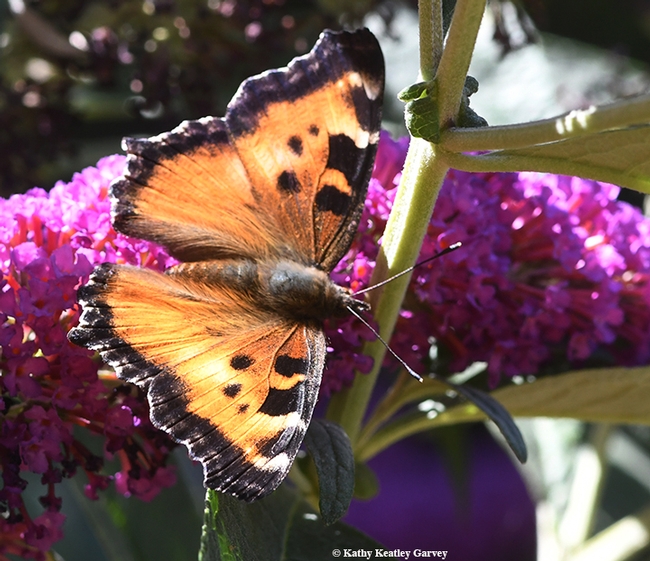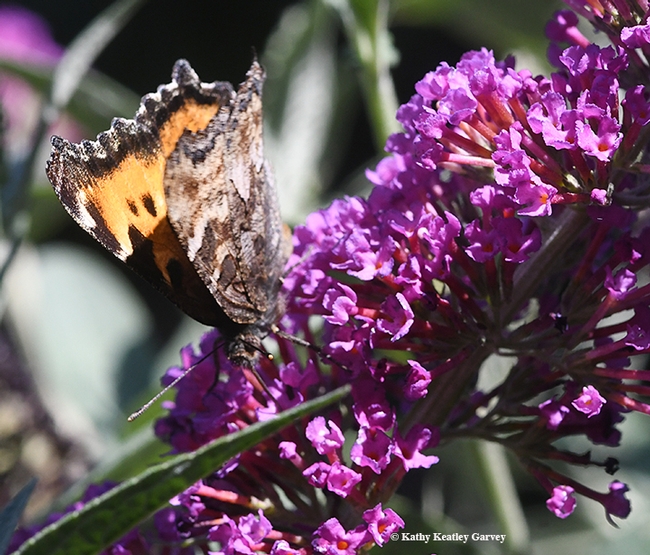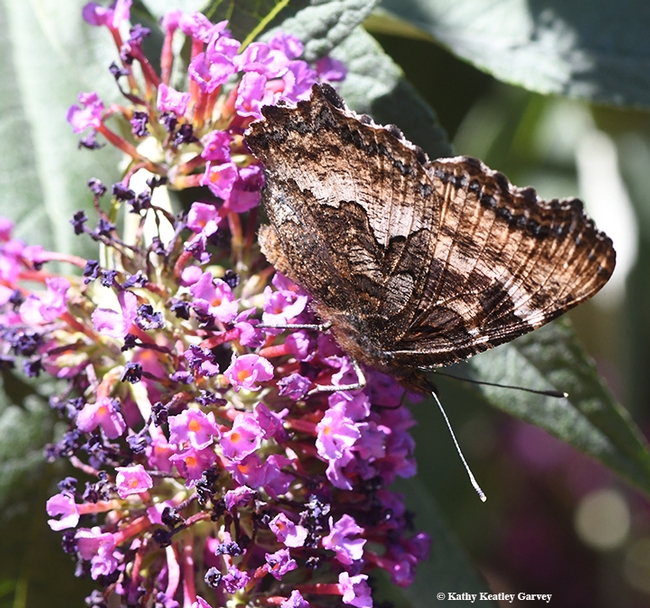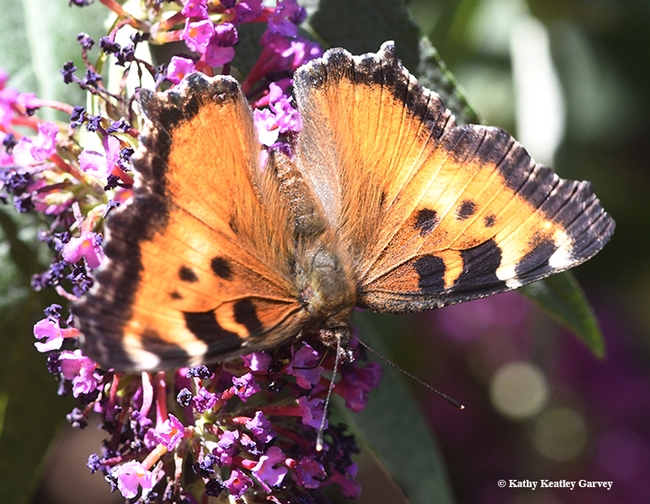A flash of orange.
Usually we see assorted orange butterflies--Gulf Fritillaries (Agraulis vanillae) or Painted Ladies (Vanessa cardui) or Monarchs (Danaus plexippus)--on our butterfly bush (Buddleia davidii).
This time the flash of orange proved to be a California Tortoiseshell (Nymphalis californica).
Its wings are pumpkin orange with huge black spots while the underwings are dullish brown and gray, resembling a dead leaf. What a perfect camouflage!
This particular Cal Tortie is probably a female, according to Art Shapiro, distinguished professor of evolution and ecology at the University of California, Davis. He has monitored the Central Valley butterfly population since 1972 and maintains a research website.
"Along with the Painted Lady, this is a mass migrant that makes news at irregular intervals by tying up traffic!" Shapiro says on his website. "The 'Tortie' overwinters as an adult and can sometimes be seen sunning itself in midwinter on mild days. It is generally common in foothill canyons in late winter, ovipositing on the young, tender growth of various species of Wild Lilac (Ceanothus)."
And just as the Gulf Frits can defoliate its host plant, the passionflower vine, so, too, can the Tortie defoliate its host plant.
"The spiny, black-marked-with-yellow larvae feed gregariously, without a web, and in big years can defoliate whole stands of the plants," Shapiro notes on his website. "They often pupate on the bare, leafless stems en masse, the grayish-violet pupae looking like some strange kind of leaf and twitching in unison when disturbed. Adults emerge in late May to early June and almost immediately emigrate, going north or east and upslope."
They're often misidentified as monarchs, Shapiro told the recent Butterfly Summit at Annie's Annuals and Perennials, Richmond. He also mentions this on his website.
"Breeding localities in summer vary widely from year to year - sometimes in the high southern Sierra, sometimes in the Cascades... sometimes only in far northeastern California or even farther north," according to Shapiro's website. "The migrant females lay on the tender growth of high-altitude Ceanothus such as Tobaccobrush and Snowbrush, which again may be defoliated. Adults emerge in late July and migrate to estivating grounds, generally above tree-line. These are often in the high country of Yosemite, Sequoia and Kings Canyon National Parks, but can even be in the Trinity Alps, South Cascades, or (as in 2005) on Mount Rose! Estivating Torties do little but 'hang out,' and many high-altitude hikers have described their encounters with millions of them in mystical terms (they often identify them as Monarchs!). In late September these butterflies scatter downslope to hibernate in the foothills--they are the late-winter butterflies of the new year. Estivators-hibernators thus may live 9 or 10 months as adults." (See more about this amazing butterfly on his website.)
Naturalist and insect photographer Greg Kareofelas, an associate of the Bohart Museum of Entomology, UC Davis, says there are a lot of Cal Torties around now. And when they disperse, "they can end up anywhere, including the valley. So not often seen in the valley, but not all that unusual."
This butterfly ended up on its namesake, the butterfly bush in our Vacaville pollinator garden.
Attached Images:

A California Tortoiseshell (Nymphalis californica) nectaring on a butterfly bush (Buddleia davidii) in Vacaville, Calif. (Photo by Kathy Keatley Garvey)

The California Tortoiseshell is bright orange with black spots on the wings, but the underside is a dullish gray-brown, resembling a dead leaf. (Photo by Kathy Keatley Garvey)

This image of the California Tortoiseshell shows the dullish brown and gray underwings, a perfect camouflage. (Photo by Kathy Keatley Garvey)

Sometimes it seems like forever before the California Tortoiseshell spreads its wings. This one did several times before it fluttered off. (Photo by Kathy Keatley Garvey)